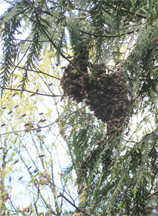The swarm season arrived at Brookfield Farm about three weeks ago, and the bees have kept me busy. I try to stop them from swarming. The bees have ample room with supers above them. I welcome them into each new super by moving brood into that super. The girls are not honey bound. They have drawn comb and foundation interspersed. And yet they build swarm cells. I guess they haven’t read the same books I read.
They don’t need to read. Swarming is natural. More colonies mean a better chance to spread the gene pool and keep it going. But we beekeepers want to keep the bees in place, producing honey for us. It’s clearly a conflict of interest.
Swarming is more intense when there is a strong nectar flow. The tendency increases when that strong flow is accompanied by sunny days intersperced with a few days of rain. It is a perfect swarm combination: Lots of food coming in, then, suddenly, the rain brings everyone inside and crowds the hive. Food and crowds: signals to swarm.
Of course, there must be queen cells in the making for the swarm, and the after swarms, to emerge. It seems that the bees constantly build and destroy queen cells. This makes sense in the world of gene survival. Something could happen to the queen at any time, an injury, death, or failure. Or there could just be a lot of food and a crowded hive, thus the need to swarm.
Regardless of the reasons, about two weeks into the big leaf maple flow, swarm cells appear. Sun, rain, and food: that’s pretty standard here in the spring. This year I made splits from every good swarm cell I found.
A nearly sealded or sealed swarm cell means that I’ve a queen ready to emerge in 10 days or less. If she’s good, and if she mates well, that means I can have a laying queen at least a week sooner than if I give a nuc eggs with which to build a queen. A frame with a good swarm cell is placed in a nuc with two or three frames of bees, brood, honey and pollen. These other frames can be taken from the same hive or a combination of hives.
You can cut swarm cells out of the comb and pin them onto the comb in a nuc or queenless hive, but I’m always worried that I will harm the developing queen. So I put the entire frame with the new queen cell into the nuc. The other swarm cells I distroyed.
But what, to me, makes a good Queen Cell?
Like so many things in this world, I judge by appearance and location. My criteria are:
The outer shell of the queen cell should be crinkly, not smooth.
The shape of the cell should be about ¾ inch long.
If it’s longer, the budding queen, if there is one in there, might be dead, and the bees have just been adding on wax to the cell.
If it’s short and stumpy, it could just be a trial run with nothing inside.
All the photos of queen cells on this page are courtesy of Dr. Zachary Huang (Dept. of Entomology, Michigan State University) from his website CyberBee.net (a fabulous website full of great information and photographs).
The location of the swarm cell can also be a clue. Most swarm cells are on the outer edges of the foundation or at the bottom. But if the queen cell is in the middle of a group of drone cells, the bees may have built a queen cell around a drone. It happens. I’ve even found queen cells on the wooden frame of the foundation, with nothing inside. Sometimes the bees just seem to want to build.
Of course if you see perfect cells in the middle of a frame, those are supercedure cells. If they all look good, I leave them all, may the best queen win.
Some beekeepers think it’s a bad idea to create hives from swarm cells; that the bees produced by these queens will be more inclined to swarm. I don’t agree with that, but it’s just my opinion. I think food, weather, and crowding lead to swarms. If you can grab the swarm cells to create new hives, it’s a blessing.
I did this about 2 weeks ago. Yesterday I checked the nucs and all but one had laying queens in them and were ready for their second brood box. For me, this was a success. New, laying queens just in time for the Cascara to blossum.



